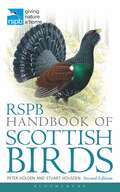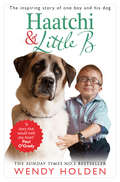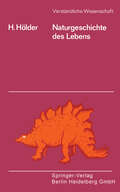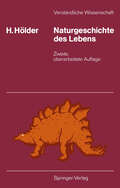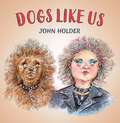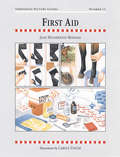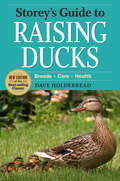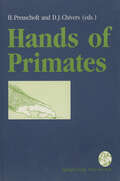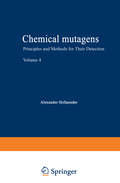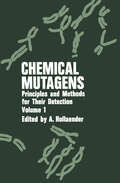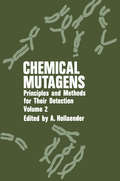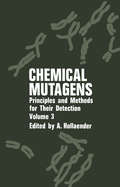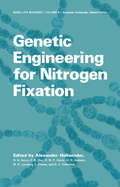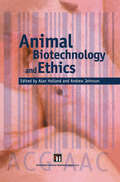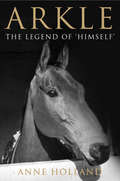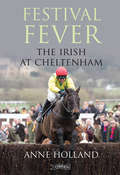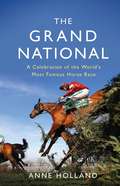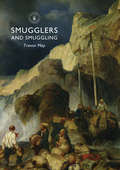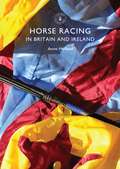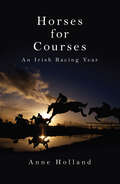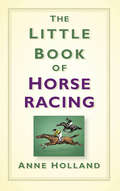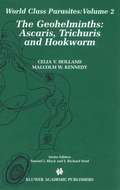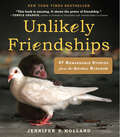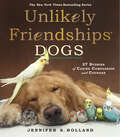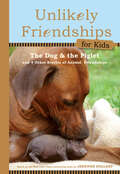- Table View
- List View
RSPB Handbook of Scottish Birds: Second Edition (RSPB)
by Peter Holden Stuart HousdenThis is a fully updated second edition of 2009's well reviewed RSPB Handbook of Scottish Birds detailing Scotland's rich birdlife. Over 250 species are covered in detail with one page per species, including Gaelic names newly added for this edition. The detailed distribution maps have been fully updated and show when birds are breeding, wintering or on migration. More than a thousand superb colour illustrations by some of the world's leading bird artists have been integrated into the text for easy reference at home or in the field. Each detailed species account includes information on identification, voice, habits, habitat, food, breeding ecology, seasonal movements, population and conservation.
Haatchi and Little B: The True Story Of One Boy And His Dog
by Wendy HoldenHaatchi and Little B tells the inspiring and moving true story of Owen Howkins (also known as Little B, short for 'Buddy') and Haatchi, an Anatolian shepherd dog who was abandoned on a railway line as a puppy and left for dead.Thankfully, Haatchi was rescued, despite sustaining severe injuries. And so Haatchi, in turn, was able to rescue Owen, at the time an anxious and withdrawn little boy born with a rare genetic disorder, who found it hard to make friends. But Owen fell in love with his new three-legged canine housemate at first sight, and life would never be the same.The touching story of this dynamic and loveable duo is a life-affirming tale of happiness and friendship.
Naturgeschichte des Lebens (Verständliche Wissenschaft #93)
by Helmut HölderDieses kleine Buch sei dem Homo sapiens gewidmet, der seit dem großen und bescheidenen DAR WIN gelernt hat, in der Welt fossilen Lebens auch die Leitlinien seines eigenen Werdens zu erkennen. Es will in knapper Fassung in den Wissensstand und die Problematik der stammesgeschichtlichen Paläontologie einführen, nachdem E. DAQUE und E. THENIUS in den Bänden 4 und 8 r dieser Reihe eine allgemeinere Darstellung über "Das fossile Lebewesen" und "Versteinerte Urkunden" gegeben haben. Dabei sollen auch einige schon historisch gewordene Erkenntnisschritte in Erinne rung gebracht werden. Endlich soll die naturwissenschaftlich ge wonnene Einsicht zum Selbstverständnis des Menschen in Be ziehung gesetzt werden, das sie einerseits prägend mitbestimmt, von dem sie andererseits aber auch begrenzt wird. HELMUT HöLDER Münster fWestf. Inhalt Natur als Geschichte? . . Schichtgesteine sind Geschichtsbücher 3 Kleiner historischer Exkurs . . . . . Noch einmal: Geschichte in Schichtsteinen 8 Vom Anfang des Lebens . . . . . . . . 9 Leben und Umwelt - Lamarckismus und Darwinismus I I Mutation und Auslese . . . . I 8 Der metaphysische Porenraum I 9 Das Gleichgewicht des Lebens 2I Einzigartigkeit des irdischen Lebens 2 3 Tier-und Pflanzenwelt . . . . . . 24 Aus der Geschichte der wirbellosen Tiere. 29 Schwämme und Korallen . . . . . 29 Entfaltung der höheren Wirbellosen 40 Mollusken 43 Gliedertiere . 57 Stachelhäuter 59 Graptolithen . 6 3 Die Entfaltung der Wirbeltiere 65 Fische . . . . . . 66 Der Schritt an Land 7I Lurche . . . . . . 76 Saurier . . . . . .
Naturgeschichte des Lebens: von seinen Anfängen bis zum Menschen (Verständliche Wissenschaft #93)
by Helmut HölderDiese auch für den Laien verständliche Einführung in die Naturgeschichte gibt einen Einblick in den derzeitigen Wissensstand und die Problematik der stammesgeschichtlichen Paläontologie. Nach kurzer Einleitung in Wesen und Wissenschaftshistorie, mit besonderem Nachdruck auf den glücklichen Umstand der so reichlich vorhandenen fossilen Überlieferungen, wird die Evolution der Pflanzen- und, etwas ausführlicher, der Tierwelt anhand der wichtigsten Organismengruppen dargestellt - ohne den Leser durch Formenfülle zu entmutigen. Dabei erfährt die Beziehung der Lebewesen zu ihrer Umwelt und dem Hin und Her der Anpassungen an Wasser, Land und Luft besondere Betonung. Einbezogen in das Gesamtgeschehen der Evolution wird auch der Mensch, sowohl in seiner physischen Entwicklung als auch in seinem Wesen und Selbstverständnis bis hin zu seiner heute ins Blickfeld gerückten Umweltverantwortung.
FIRST AID (Threshold Picture Guide Ser. #No.12)
by JANE HOLDERNESS-RODDAMThis edition, substantially revised, reflects recent developments and practical advice on how to cope with common equine injuries and ailments. It explains when to call the veterinarian, and what to do before the vet arrives. New ideas are explored on wound care and laminitis.
Storey's Guide to Raising Ducks, 2nd Edition: Breeds, Care, Health (Storey’s Guide to Raising)
by Dave HolderreadWith in-depth information on feeding, housing, behavior, and health care, this comprehensive guide also provides proven strategies for creating a profitable business plan and marketing your products. Whether you&’re about to acquire your first ducks or are interested in experimenting with rare breeds, Storey&’s Guide to Raising Ducks will help you achieve your duck-raising goals.
Hands of Primates
by Holger Preuschoft and David J. ChiversThe hand commonly is considered to have exerted great influence on the evolution of typically human characteristics, like upright posture, stereoscopic vision, «manipulative» handling of parts of the environment. The German term «Begreifen», which is commonly used for the understanding of complex relationships in a generalised, abstract sense, always implies the original meaning of seizing objects with the aid of the hands. The hands are also of greatest importance for the survival of the other, non-human primates. Hands are absolutely essential for locomotion in an arboreal habitat, and the intake of food is dependant on the use of the hands as well: primates very rarely take in food directly with their mouths, in the wast majority of cases they seize food items with their hands. Even drinking is often performed by dipping the hand into the water and licking the drops from hand and forearm. An organ of such importance will very probably be «adapted» to its «function». This statement is made so often, that any further considerations seem superfluous. Nobody doubts, that the hands of primates are highly adaptive organs, the general form and internal structure of which are closely related to the necessities of life. However, if one tries to go beyond this general statement, he finds himself confront ed with several problems: First of all, a point which W. GUTMANN has emphasized repeatedly: according to the results obtained by genetics, the first thing to appear is the mutated character.
Chemical Mutagens: Principles and Methods for Their Detection Volume 4 (pdf)
by Alexander HollaenderChemical Mutagens: Principles and Methods for Their Detection Volume 1
by Alexander HollaenderAs editor I want especially to thank Dr. Ernst Freese for helpful co operation in preparing these volumes, and to express my appreclatlOn to Drs. Kurt Hirschhorn and Marvin Legator, the other members of the editorial board. Alexander Hollaender January 1971 Preface The purpose of these volumes is to encourage the development and ap plication of testing and monitoring procedures to avert significant human exposure to mutagenic agents. The need for protection against exposure to possibly mutagenic chemicals is only now coming to be generally realized. The recently issued Report of the Secretary's Commission on Pesticides and Their Possible Effects on Health (the Mrak Report-U.S. Department of Health, Education and Welfare, December 1969) has made an important start. Its Panel on Mutagenicity recommends that all currently used pesticides be tested for mutagenicity in several recently developed and relatively simple systems. Whether recommendations such as these are actually put into effect will depend on convincing government, industry, and the public that the problem is important, that the proposed tests would be effective, and that they can be conducted at a cost that is not prohibitive. Why is it important to screen environmental agents for mutagenic activity? To those who will read this book, the answer is self-evident. The sine qua non of all that we value and all that we are is our genetic heritage.
Chemical Mutagens: Principles and Methods for Their Detection: Volume 2
by Alexander HollaenderThe best protection against environmental mutagens is to identify them before they ever come into general use. But it is always possible that some substance will escape detection and affect a large number of persons without this being realized until later generations. This article considers ways in which such a genetic emergency might be promptly detected. A mutation-detecting system should be relevant in that it tests for effects that are as closely related as possible to those that are feared. It should be sensitive enough to detect a moderate increase in mutation rate, able to discover the increase promptly before more damage is done, responsive to various kinds of mutational events, and designed in such a way as to maxi mize the probability that the Gause of an increase can be found. Methods based on germinal mutation necessarily involve enormous numbers of persons and tests. On the other hand, with somatic mutations the individual cell becomes the unit of measurement rather than the in dividual person. For this reason, I think that somatic tests are preferable to germinal tests, despite the fact that it is germinal mutations which are feared.
Chemical Mutagens: Principles and Methods for Their Detection Volume 3
by Alexander HollaenderThe ready acceptance and wide demand for copies of the first two volumes of Chemical Mutagens: Principles and Methods Jar Their Detection have demon strated the need for wider dissemination of information on this timely and urgent subject. Therefore, it was imperative that a third volume be prepared to include more detailed discussions on techniques of some of the methods that were presented from a theoretical point of view in the first two volumes, and to update this rapidly expanding field with current findings and the new developments that have taken place in the past three years. Also included is a special chapter by Dr. Charlotte Auerbach giving the historical background of the discovery of chemical mutagenesis. Methods for recognizing mutagenic compounds in vitro are a necessary preliminary step toward arriving at satisfactory solutions for recognizing significant mutation rates in man, which must be done before our test tube methods of detection can be considered reliable. Two chapters in this volume make important contributions to this problem. Due to the increasing activity in efforts to perfect techniques for detecting chemical mutagens and their effects on man, it is planned to continue this series of volumes as necessary to keep abreast of current findings.
Genetic Engineering for Nitrogen Fixation (Basic Life Sciences #9)
by Alexander HollaenderThere is a time in scientific research when a number of developments coincide making it possible to progress with a tough and complicated problem. It is believed that such a time has come in the area of biological nitrogen fixation. A better understanding of photosynthesis, cell hybridization, plasmid, and gene transfer between cells not necessarily genetically related, have opened new avenues of research. New developments in traditional genetics, cell biology, biochemistry, including enzyme chemistry, and plant physi ology have brought about the feeling this is a most appro priate time to pull together the different approaches in a conference where the lines of research could be discussed and thus help to speed up developments in this area. What makes biological nitrogen fixation especially im portant is the promise that a good understanding of the basic problem would help us to make organisms more amenable to fix nitrogen, not only in symbiosis with legumes, but also with other plant species and develop a wider variety of organisms with the ability to fix N • It will also 2 encourage a search for naturally occurring N2 fixing organ isms other than the traditional N2 fixers. Some success has already been encountered in this area. Success in broadening the field of nitrogen fixing would help to increase food supply, especially in de veloping countries which cannot afford to purchase synthetic nitrogen sources.
Animal Biotechnology and Ethics
by Alan J. Holland Andrew JohnsonAdvanced biomedical techniques such as genetic engineering are now used extensively in animal related research and development. As the pace of development has quickened, there has been growing public anxiety about the ethical issues involved. Animal Biotechnology and Ethics draws together in one book some of the leading themes and issues which have emerged in the recent debates surrounding biotechnology as applied to animals. With contributions from authors of many different viewpoints, the subject is given a thorough and balanced treatment. Among those to whom the book will be of particular interest are practitioners of animal biotechnology, and those whose interest lies in assessing its credentials, such as philosophers and social or political scientists. It also has a great deal to interest policy-makers and pressure groups, as well as more general readers. The strong chapters on the legal and regulatory framework will make it useful to those involved in advising on company policy, patenting or litigation.
Arkle: The Legend of 'Himself'
by Anne HollandIn 1964, Arkle's first-place finish in the Cheltenham Gold Cup was the first big win by Ireland's most celebrated racehorse: the horse by which all others are measured. Fifty years on from the start of his incredible career - which included wins in the Cheltenham Gold Cup (three times), Irish Grand National, Hennessy Gold Cup, King George VI Chase and Punchestown Gold Cup - Anne Holland looks at Arkle's life and legend through the eyes of those who knew him best. She describes Arkle's career, his incredible wins, and the people involved with him, interviewing many of his connections, including Jim Dreaper, Paddy Woods, Tom Taaffe, sculptor Emma McDermott, the Baker family and others. Arkle was a star - the story goes that he received items of fan mail addressed to 'Himself, Ireland' - and this is a well-researched and intimate portrait of a legendary horse. Shortlisted for Horse Racing Book of the Year 2014, British Sports Book Awards
Festival Fever: The Irish at Cheltenham
by Anne HollandIt is said the land level of Ireland rises a few feet every March because so many people have left for the National Hunt Festival at Cheltenham. English-Irish rivalry at this pinnacle of jump racing has always been keen but it has risen to new levels in the 21st Century, with many Irish winners across all the races, including the Gold Cup, Queen Mother Chase, Champion Hurdle and Stayers Hurdle. But Festival Fever, The Irish At Cheltenham is about more than the winners, it is the whole atmosphere, the mix of ex-pat and visiting Irish among the thronging crowds, the craic; what goes on behind the scenes; many surprising stories are told. It is also about the fascinating history – racing was banned at Cheltenham for a period during the 19th century; and the 1980s saw a dearth of Irish runners which led to enterprising attempts by the racecourse to woo them back.
The Grand National: A Celebration of the World’s Most Famous Horse Race
by Anne HollandEvery year the Grand National produces very different stories from jockeys and horses alike; uplifting scenes from a victor and heartbreak when a mere inch divides the loser from the winner at the end of nearly four-and-a-half miles and 30 challenging fences. The race has evolved over the years but there is one constant: luck, or the lack of it. How fitting, then, that in 1839 the first winner was named Lottery. Back then, huge crowds rode to Aintree by horseback, in carriages, carts or on foot. Hotels were so full that some slept four guests to a bed. Today the Grand National is probably the world's most famous horse race, with a global television audience of some 600 million in 140 countries.Anne Holland's richly informed book focuses on the race's various record-breakers, rather than being a purely chronological history. In this greatest of all steeplechases, many records have stood the test of time. It is still jockey George Stevens from the 19th century who has ridden the most winners - five. In 2019, Tiger Roll's second consecutive victory was the first time that the feat had been achieved since Red Rum in 1973-74, and before that, Reynoldstown in 1935-36. Throughout its vivid history, many people have been opposed to the Grand National, claiming it to be dangerous. During the 21st century the famous fences have been modified, the drop at Becher's Brook reduced, and the landing levelled. All this has led to a laudable reduction in injuries.The Grand National continues to provide men, women and diverse thoroughbred horses with a true test of skill, bravery and perseverance. Anne Holland's authoritative history celebrates one of the world's greatest sporting spectacles.
Horse Racing: In Britain and Ireland (Shire Library #760)
by Anne HollandOften called the sport of kings, horse racing dates back at least to the chariot races of the ancient Olympic Games. Arriving in Britain with the Romans in the first century BC, its popularity among the elite led to the breeding of thoroughbred racehorses and prompted the establishment of a formal racing calendar with flat races and steeple chases at a plethora of dedicated racecourses throughout the country. Now no longer restricted to the aristocracy, a day at the races has become a perennial highlight of the social calendar. Shedding new light on this increasingly popular equestrian sport, Anne Holland here explores the broad history of horse racing from the horses, jockeys and racecourses to the practice of bookmaking and those in the audience.
Horse Racing in Britain and Ireland (Shire Library)
by Anne HollandOften called the sport of kings, horse racing dates back at least to the chariot races of the ancient Olympic Games. Arriving in Britain with the Romans in the first century BC, its popularity among the elite led to the breeding of thoroughbred racehorses and prompted the establishment of a formal racing calendar with flat races and steeple chases at a plethora of dedicated racecourses throughout the country. Now no longer restricted to the aristocracy, a day at the races has become a perennial highlight of the social calendar. Shedding new light on this increasingly popular equestrian sport, Anne Holland here explores the broad history of horse racing from the horses, jockeys and racecourses to the practice of bookmaking and those in the audience.
Horses for Courses: An Irish Racing Year
by Anne HollandThere can be no better way of getting to know Ireland than by visiting its racecourses: from the glamour of Leopardstown and the class of The Curragh to the majestic mountains around Killarney; from the warm welcome at Gowran Park and Clonmel to the summer holidaymakers' meetings and 'industry' days in the winter months. At any one of these venues, you might catch a glimpse of a future Cheltenham Gold Cup champion or Derby winner in action.Horses for Courses guides readers through a typical year in Irish racing and highlights the individuality of each venue. All have their own special qualities and atmosphere but share two common traits: a warm welcome and good sport. And that is what the author believes Irish racing is all about.The country's courses enjoy a huge level of support from the local population. It might be raining and some of the races may be 'ordinary' but the stands will always be crowded. That is because racing is part of Irish culture and the nation's way of life: with 27 courses, it has proportionately far more venues than Great Britain.Meticulously researched and passionately written, Horses for Courses is the definitive guide to Ireland's racecourses and is essential reading for horse-racing enthusiasts everywhere.
The Little Book of Horse Racing (Little Book Ser.)
by Anne HollandDo you know what the oldest horse race in Britain is, where the term ‘gee-gee’ comes from, or who is credited with bringing racing to Ascot? Fact-packed but light-hearted in style, this reliable reference book and quirky guide reveals little-known facts, details of classic races, famous riders, racing records, amusing anecdotes and criminal goings-on. A compendium of the fascinating, strange and entertaining, The Little Book of Horse Racing can be dipped into time and time again to reveal something new about this ancient sport.
The Geohelminths: Ascaris, Trichuris and Hookworm (World Class Parasites #2)
by Celia V. Holland Malcolm W. KennedyThe soil-transmitted nematode parasites, or geohelminths, are - called because they have a direct life cycle, which involves no intermediate hosts or vectors, and are transmitted by faecal contamination of soil, foodstuffs and water supplies. They all inhabit the intestine in their adult stages but most species also have tissue-migratoryjuvenile stages, so the disease manifestations they cause can therefore be both local and systemic. The geohelminths together present an enormous infection burden on humanity. Those which cause the most disease in humans are divided into three main groupings, Ascaris lumbricoides (the large roundworm), Trichuris trichiura (whipworm), and the blood-feeding hookworms (Ancylostoma duodenale and Necator americanus ), and this book concentrates on these. These intestinal parasites are highly prevalent worldwide, A. lumbricoides is estimated to infect 1471 million (over a quarter ofthe world’s population), hookworms 1277 million, and T. trichiura 1049 million. The highly pathogenic Strongyloides species might also be classified as geohelminths, but they are not dealt with here because the understanding of their epidemiology, immunology and genetics has not advanced as rapidly as for the others. This is primarily because of the often covert nature of the infections, with consequent difficulties for analysis. If there is ever a second edition of this book, then there will hopefully be much to say about this infection.
Unlikely Friendships: 47 Remarkable Stories from the Animal Kingdom (Unlikely Friendships)
by Jennifer S. HollandThe most amazing friendships between species, collected from around the world, documented with full-color photographs, and narrated by New York Times bestselling author Jennifer Holland. The cat and the bird. The elephant and the sheep. The snake and the hamster. In all, 47 heartwarming and inspiring true tales of animal bonds.
Unlikely Friendships: 37 Stories of Canine Compassion and Courage (Unlikely Friendships)
by Jennifer S. HollandTwenty-eight new stories of canine companionship and courage, plus nine classic dog stories from the New York Times bestselling Unlikely Friendships series. From the pit bull who plays with a tortoise to the mastiff who rescued 17 horses, these inspiring true stories are enhanced with full-color photographs and will warm the heart of any dog lover.
Unlikely Friendships for Kids: And Four Other Stories of Animal Friendships (Unlikely Friendships for Kids #1)
by Jennifer S. HollandGood friends come in all shapes and sizes!Unlikely Friendships, the runaway New York Times bestseller with a compelling message of hope and friendship and differences overcome, is rewritten just for younger readers. This hardcover chapter book for children ages seven and up collects five heartwarming true stories of animal friendship: a hippo and the goat who is his best friend, an iguana that snuggles with a cat, a dog that takes care of a blind deer, a cat and orangutan who become friends, and a mother dog who cares for a tiny piglet. Chapter books give young readers a strong sense of accomplishment, and these heartwarming animal stories, with their incredible photographs and inexplicable mysteries of attraction, their focus on friendship, love, and the ways that creatures of all different species can find common bonds of affection, will keep kids turning the pages to find out about the unusual ways animals help each other and discover the love of new friends. Each is a perfect gift for young animal lovers, and a lovely subject to help kids get reading.
